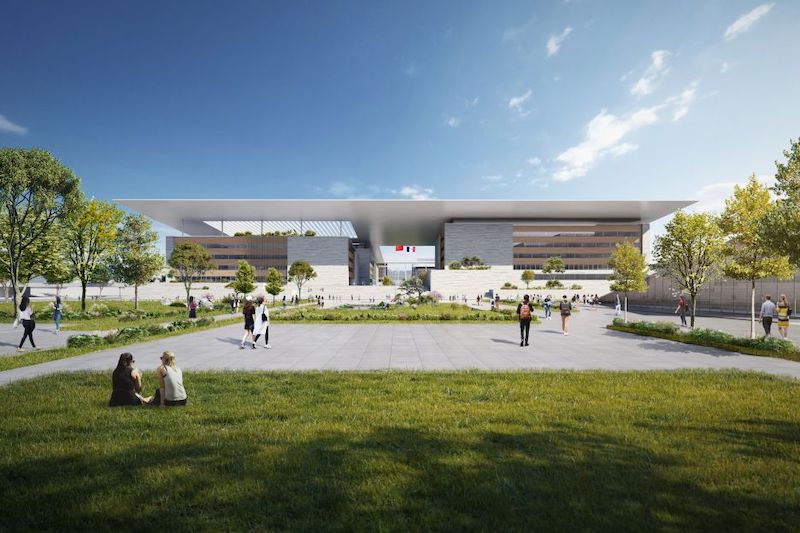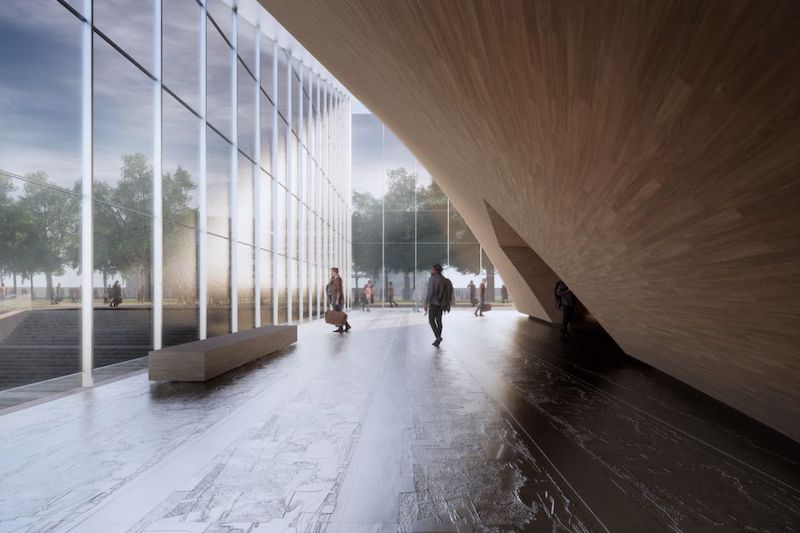HENN has unveiled the design for the Sino-French Aviation University. The concept draws on the traditional culture of Liangzhu, a UNESCO World Heritage site located in the Yangtze River Delta. Of the 1.5 million sm, 660,000 sm are dedicated to the academic campus and 930,000 sm host the science and technology park with corporate and commercial companies.
The campus’s central building and its flying roof are the most important design element of the project. The lightweight, concave roof sits atop the main building and opens itself towards the sky, meant to resemble a plane taking off. Public and shared functions, such as research labs, classrooms, conference halls, the canteen, and sports halls, are distributed among the central building.

The overall planning skeleton of the project comprises an industry-academia axis and an urban landscape axis. The industry-academia axis connects to the north and the south with courtyards, squares, and roads, while combining public teaching, labs, and service function buildings. The landscape axis connects the green corridor on the west side of the city with the east-west main entrance of the campus. It extends to the mountain on the east side to become the main landscape corridor of the campus.
See Also: GLY Construction to build underground, robotic parking garage for Seattle Cancer Care Alliance
The buildings’ facades incorporate rough natural materials and masonry texture, and modern technical components like glass, concrete, and steel complement the traditional Chinese facade parts.



Related Stories
| Oct 17, 2011
Clery Act report reveals community colleges lacking integrated mass notification systems
“Detailed Analysis of U.S. College and University Annual Clery Act Reports” study now available.
| Oct 14, 2011
University of New Mexico Science & Math Learning Center attains LEED for Schools Gold
Van H. Gilbert architects enhances sustainability credentials.
| Oct 12, 2011
Bulley & Andrews celebrates 120 years of construction
The family-owned and operated general contractor attributes this significant milestone to the strong foundation built decades ago on honesty, integrity, and service in construction.
| Sep 30, 2011
Design your own floor program
Program allows users to choose from a variety of flooring and line accent colors to create unique floor designs to complement any athletic facility.
| Sep 23, 2011
Okanagan College sets sights on Living Buildings Challenge
The Living Building Challenge requires projects to meet a stringent list of qualifications, including net-zero energy and water consumption, and address critical environmental, social and economic factors.
| Sep 14, 2011
Research shows large gap in safety focus
82% of public, private and 2-year specialized colleges and universities believe they are not very effective at managing safe and secure openings or identities.
| Sep 7, 2011
KSS Architects wins AIA NJ design award
The project was one of three to win the award in the category of Architectural/Non-Residential.
| May 18, 2011
Major Trends in University Residence Halls
They’re not ‘dorms’ anymore. Today’s collegiate housing facilities are lively, state-of-the-art, and green—and a growing sector for Building Teams to explore.
| May 18, 2011
Raphael Viñoly’s serpentine-shaped building snakes up San Francisco hillside
The hillside location for the Ray and Dagmar Dolby Regeneration Medicine building at the University of California, San Francisco, presented a challenge to the Building Team of Raphael Viñoly, SmithGroup, DPR Construction, and Forell/Elsesser Engineers. The 660-foot-long serpentine-shaped building sits on a structural framework 40 to 70 feet off the ground to accommodate the hillside’s steep 60-degree slope.
















